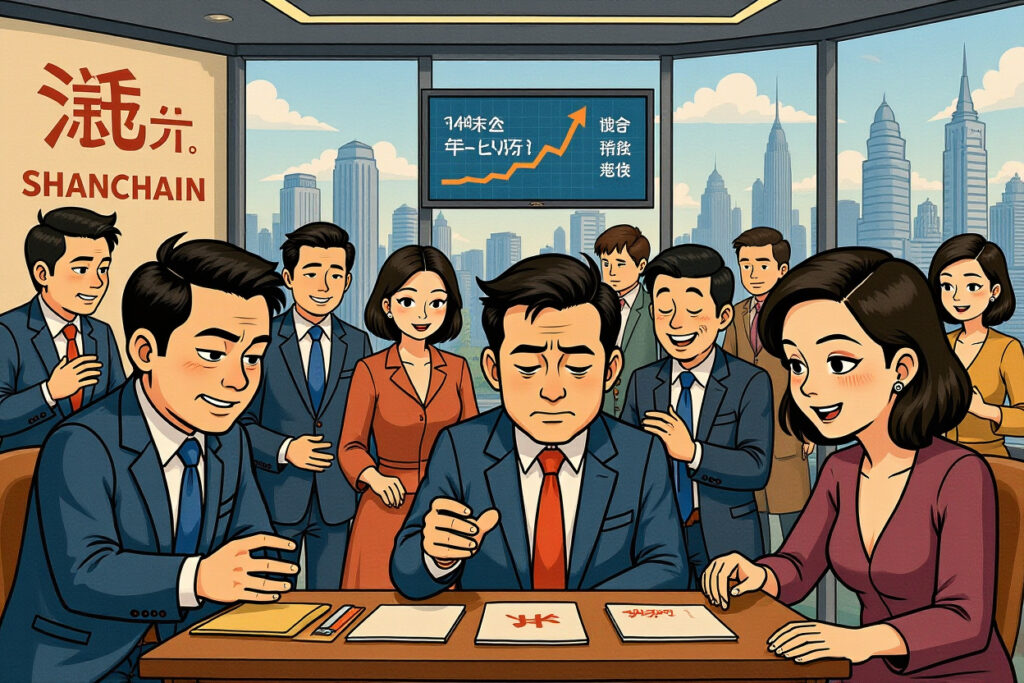China’s Steel Sector Navigates Growth and Reform Under New Two-Year Blueprint
China’s massive steel industry, a bellwether for the nation’s industrial health and a critical component of global supply chains, has received its marching orders for the next two years. The Ministry of Industry and Information Technology (MIIT) 工业和信息化部, alongside other government bodies, has released the Steel Industry Steady Growth Work Plan (2025-2026) 钢铁行业稳增长工作方案(2025—2026年). This pivotal document charts a course of managed expansion, targeting an average annual growth rate of approximately 4% in value-added terms, while simultaneously enforcing a strict prohibition on new capacity. This dual-pronged strategy of ‘steady growth, preventing internal involution’ (稳增长、防内卷) signals a mature phase for the world’s largest steel producer, prioritizing quality, efficiency, and environmental sustainability over raw output volume.
For global investors and corporate executives, this policy framework is far more than a domestic directive. It represents a fundamental shift in how China manages its core industrial base, with profound implications for global commodity prices, industrial margins, and the competitive landscape. The plan’s emphasis on ‘preventing internal involution’—a term describing destructive, profit-eroding competition within an oversupplied market—directly addresses long-standing concerns about Chinese overcapacity distorting global markets. The success of this Steady Growth Work Plan will be a key determinant of profitability for steelmakers worldwide and a critical data point for assessing China’s broader economic rebalancing efforts.
Key Takeaways for the Market
- – Mandated 4% annual value-added growth through 2026 signals controlled, quality-focused expansion, not a return to volume-driven growth.
- – An absolute ban on new steel production capacity reinforces Beijing’s commitment to tackling overcapacity and protecting industry margins.
- – Forced technological upgrades and ultra-low emission standards will accelerate industry consolidation, favoring large, technologically advanced producers.
- – The policy directly tackles ‘internal involution,’ aiming to eliminate cut-throat price competition and create a more stable, profitable market structure.
- – Compliance deadlines, including the 2025 target for 80% of capacity to meet ultra-low emission standards, create urgent capital expenditure requirements for producers.
Decoding the Steel Industry Steady Growth Work Plan
The newly unveiled Steel Industry Steady Growth Work Plan is a comprehensive response to the complex challenges facing the sector. Its core objective is to navigate the delicate balance between maintaining stable economic contribution and executing a painful but necessary structural overhaul. The 4% growth target is intentionally modest compared to historical growth spurts, reflecting a new reality where GDP growth is no longer solely tied to heavy industrial output. This figure is aligned with broader national goals of high-quality development, emphasizing the value created per tonne of steel rather than the total number of tonnes produced.
The term ‘preventing internal involution’ is the philosophical heart of the document. It acknowledges that the industry’s past success has bred its greatest weakness: too many producers chasing too little demand, leading to brutal price wars that cripple profitability and stifle innovation. The Steady Growth Work Plan is designed to break this cycle. By capping capacity and guiding resources toward ‘advantaged enterprises,’ the government is effectively picking winners and losers, a move that will dramatically reshape the industry’s hierarchy. This policy is not about stifling the market, but about creating the conditions for a healthier, more sustainable market to function.
Implementation Mechanisms and Regulatory Tools
The MIIT will not rely on suggestions alone. The plan outlines concrete mechanisms for implementation, chief among them ‘precise control’ of capacity and output. This likely involves a continuation and refinement of the seasonal production curbs often mandated in heavy pollution periods, but with a more nuanced, data-driven approach. Authorities may set output quotas based on a mill’s environmental performance, technical efficiency, and financial health, directly linking production rights to compliance with broader policy goals.
Furthermore, the push for ‘graded and classified management’ of steel enterprises is a critical tool. This system will create a transparent hierarchy of producers, with those at the top (deemed ‘advantaged’ or ‘A-grade’) receiving preferential access to financing, energy quotas, and policy support. Those at the bottom will face relentless pressure to either improve, be acquired, or exit the market entirely. This official stratification provides clarity for investors, who can now more accurately assess which companies are aligned with state policy and thus positioned for long-term survival and success.
The Absolute Ban on New Steel Production Capacity
The directive to ‘strictly prohibit new capacity’ (严禁新增产能) is the most unequivocal element of the entire Steel Industry Steady Growth Work Plan. This is not a new policy—a version of it has been in place for years—but its reiteration within this two-year plan extinguishes any lingering speculation that Beijing might relax its stance to stimulate short-term economic activity. The ban is absolute and comprehensive, covering all forms of new greenfield projects and significant expansion of existing facilities. The government’s message is clear: the era of solving problems by building more is over.
This prohibition is the essential prerequisite for all other reforms. Without a hard cap on the total size of the industry, efforts to encourage consolidation, improve efficiency, and boost profitability would be futile, as any gains would be instantly erased by new, low-cost capacity entering the market. For global competitors, this is a welcome commitment. It reduces the perennial fear of a new wave of Chinese exports flooding the market and depressing global prices, potentially leading to a more stable and predictable pricing environment for steel worldwide.
Replacing Expansion with Optimization: The ‘Capacity Swap’ Model
While new capacity is forbidden, modernization is not. The primary mechanism for upgrading existing facilities is the ‘capacity swap’ (产能置换) policy. This allows a company to build new, more efficient and cleaner furnaces only if it simultaneously dismantles a larger amount of old, inefficient capacity. The net effect is a reduction in total potential output but a significant increase in quality and environmental performance. The Steady Growth Work Plan aggressively promotes this model, effectively mandating that the only path forward for producers is to replace and improve, not to expand.
This has immediate implications for capital expenditure. Major players like China Baowu Steel Group 中国宝武钢铁集团 and Ansteel Group 鞍钢集团 are already deep into multi-billion dollar capacity swap programs. For smaller, financially weaker mills, the high cost of compliance with these swap ratios presents an existential threat. They cannot afford to build new facilities, making them likely targets for acquisition or forced closure. This dynamic is a powerful catalyst for the consolidation that authorities are actively seeking, directly supporting the plan’s goal of ‘guiding resource elements toward advantage enterprises.’
Technological Upgrades and the Mandate for Ultra-Low Emissions
Beyond managing quantity, the Steel Industry Steady Growth Work Plan is deeply focused on qualitative transformation. The plan identifies ‘equipment updates’ and ‘low-carbon transition’ as the two core pillars of future competitiveness. This is a direct instruction to the industry to invest heavily in technology or risk obsolescence. The policy specifically targets the accelerated elimination of outdated equipment, particularly old blast furnaces and converters, which are significant contributors to pollution and are less efficient than modern alternatives.
The most concrete and time-sensitive technological target is the mandate for ultra-low emissions. The plan requires that over 80% of China’s steel production capacity must complete ultra-low emission transformation by the end of 2025. This is an incredibly ambitious goal that compels every major producer to invest significant capital into sintering plant filters, furnace gas recovery systems, and comprehensive continuous emission monitoring systems (CEMS). The cost of compliance is enormous, running into tens of billions of dollars across the industry, but it is non-negotiable. This deadline creates a clear timeline for investors to monitor, as companies that fall behind risk severe operational restrictions.
Low-Carbon Transition as a Strategic Imperative
The work plan aligns the steel industry’s future directly with China’s national ‘Dual Carbon’ goals (碳达峰、碳中和)—peaking carbon emissions by 2030 and achieving carbon neutrality by 2060. Steel production is one of the largest industrial sources of CO2 emissions, making its decarbonization a national priority. The plan encourages, and will likely soon mandate, a shift toward hydrogen-based direct reduced iron (DRI) processes, electric arc furnaces (EAFs) powered by renewable energy, and carbon capture, utilization, and storage (CCUS) technologies.
This transition is no longer just an environmental story; it is a fundamental business and competitive one. Producers that pioneer low-carbon steelmaking will future-proof their operations against increasingly stringent regulations and capture growing demand from downstream manufacturers (like automotive and appliance makers) who are under pressure to reduce the carbon footprint of their own supply chains. The Steady Growth Work Plan effectively makes green technology a primary determinant of which companies will thrive in the coming decade.
Market Implications and Strategic Guidance for Investors
The implementation of this Steel Industry Steady Growth Work Plan will create clear winners and losers, realigning investment risk and opportunity. The outright ban on new capacity is a powerful tailwind for incumbent leaders, as it protects their market share from new entrants and stabilizes the supply-demand balance. The largest, most technologically advanced, and state-backed producers, such as China Baowu 中国宝武, are poised to be the biggest beneficiaries. They have the financial strength to fund the necessary environmental upgrades and capacity swaps, and they will be first in line to acquire assets from struggling smaller players.
Conversely, smaller, privately-owned mills with weaker balance sheets and older equipment face an intense squeeze. Unable to finance expensive upgrades and unable to expand, their options are narrowing to either being acquired or shuttered. Investors should be highly selective, focusing on companies with a clear path to complying with 2025 emission targets, strong government connections, and a leading role in the ongoing industry consolidation. The plan reduces systemic risk for the sector by tackling overcapacity but increases idiosyncratic risk for individual firms that fail to adapt.
Global Ripple Effects and Commodity Dynamics
For the global market, a successful execution of this Chinese plan would be profoundly bullish for steel prices and producer margins worldwide. By definitively capping its own capacity, China removes the largest source of potential global oversupply. This could lead to a new, more stable era for the global steel industry, with higher and less volatile prices. However, the transition may not be smooth. In the short term, the push to close old facilities could temporarily disrupt supply chains and increase import demand for certain steel products, creating opportunities for exporters in other regions.
Furthermore, China’s focus on high-value, environmentally friendly steel production could see it move up the value chain, competing more directly with premium producers in South Korea, Japan, and Europe in certain product segments, rather than competing solely on volume and price in lower-tier products. The Steel Industry Steady Growth Work Plan is therefore not just a domestic policy document; it is a statement of strategic intent that will reshape global trade flows and competitive dynamics for years to come.
Navigating the New Era of Chinese Steel
The Steel Industry Steady Growth Work Plan (2025-2026) marks a definitive turning point. It moves the sector from a period of rapid, often chaotic, expansion to an era of managed, quality-focused development. The 4% growth target is symbolic of this new phase—ambitious enough to support economic stability but restrained enough to force a focus on value over volume. The rigorous enforcement of the capacity ban and the strict emission deadlines provide a clear and enforceable framework for this transition.
The successful implementation of this plan hinges on the consistent application of these rules across all provinces, preventing local governments from protecting inefficient ‘zombie’ enterprises for short-term employment gains. If Beijing holds the line, the result will be a leaner, greener, and more profitable Chinese steel industry that is better integrated into the global economy and a more stable participant in world markets. The era of ‘internal involution’ is being deliberately phased out, to be replaced by a competition based on technology, efficiency, and environmental performance.
For institutional investors and corporate strategists, the path is clear. Due diligence must now heavily weight a Chinese steel producer’s compliance roadmap, technological capability, and financial capacity to navigate this mandatory upgrade cycle. The companies that embrace this Steady Growth Work Plan not as a constraint but as a blueprint for future competitiveness will emerge as the dominant players in the world’s most important steel market. The next two years will be critical; monitor capacity utilization rates, merger and acquisition activity, and progress toward that 80% ultra-low emission target for the clearest signals of success.




